Compression socks, which reach just below the knee, apply graduated pressure to support venous return, reduce discomfort from edema, and alleviate varicose veins. In contrast, compression stockings extend above the knee to the thigh and are used for more severe venous insufficiency or post-operative recovery. They promote better blood flow from the lower extremities to the heart, helping prevent deep vein clots and improving overall circulation.
Compression socks and compression stockings are two essential medical garments designed to promote blood circulation in the legs. While they share a common purpose, they differ in their form and application. Compression socks, often reaching just below the knee, provide graduated pressure to support venous return and alleviate discomfort associated with various conditions like edema and varicose veins.
On the other hand, compression stockings extend further up the leg, typically covering the entire thigh, and are used for more severe venous insufficiencies or post-operative recovery. Both options play a crucial role in enhancing circulatory health, yet their distinctions make them suited for distinct medical needs and preferences.
This article aims to delve into the characteristics, benefits, and appropriate applications of compression socks and compression stockings, offering valuable insights for individuals seeking relief from circulatory challenges.
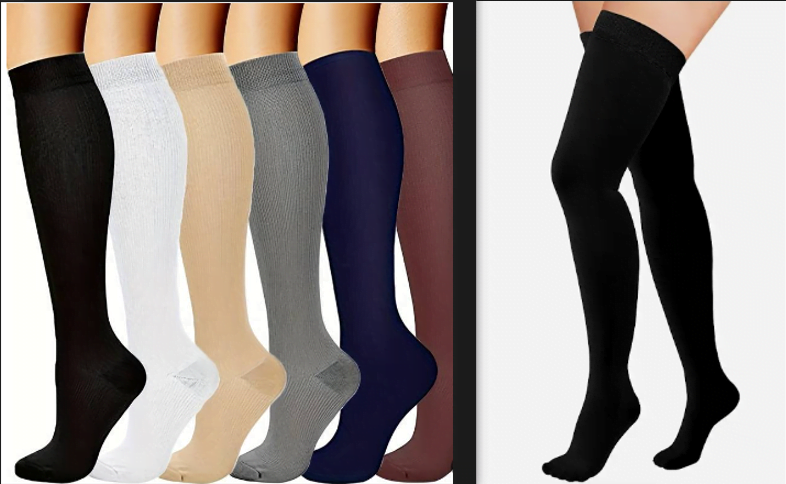
Compression Sock VS Compression Stocking
What is a Compression Sock
A compression sock is a specialized garment designed to improve blood circulation in the legs by applying gentle pressure. It is typically made from elastic materials that exert graduated compression, meaning the pressure is highest at the ankle and gradually decreases as it moves up the leg. This design helps to facilitate the flow of blood back to the heart, preventing pooling in the veins and reducing the risk of various circulatory issues.
Compression socks are commonly used to alleviate symptoms associated with conditions like edema (swelling), varicose veins, deep vein thrombosis (DVT), and venous insufficiency. They can also be beneficial for athletes, travelers, and individuals who spend extended periods of time sitting or standing, as they can help prevent fatigue and discomfort in the legs.
It’s important to note that compression socks come in various levels of compression, and the appropriate level should be determined by a healthcare professional based on the specific needs of the individual. They can be found in different styles, colors, and lengths, ranging from ankle-high to thigh-high, to cater to individual preferences and medical requirements.
Health Benefits of wearing Compression Sock
1. Edema (Swelling): Compression socks help reduce swelling in the legs by aiding the return of blood and fluid from the tissues back into the circulatory system.
2. Varicose Veins: They provide support to the veins, helping to improve their function and reduce the discomfort associated with varicose veins.
3. Deep Vein Thrombosis (DVT): For individuals at risk of DVT, especially during long periods of immobility (such as during travel or after surgery), compression socks can assist in preventing blood clots from forming.
4. Venous Insufficiency: They are a crucial component of treatment for conditions where the veins have difficulty returning blood to the heart, improving overall circulation.
5. Athletes: Compression socks can aid athletes by reducing muscle vibration, which may lead to less fatigue during and after physical activity. They also assist in muscle recovery.
6. Travelers: Long flights or car rides can lead to blood pooling in the legs. Wearing compression socks during travel can help maintain healthy blood flow and reduce the risk of circulation-related issues.
7. Extended Periods of Sitting or Standing: People who have jobs or lifestyles that require prolonged periods of sitting or standing can benefit from compression socks. They promote circulation, reducing the likelihood of discomfort, swelling, and fatigue.
It’s important for individuals to consult a healthcare professional to determine the appropriate level of compression and style of sock for their specific needs. Proper fit is crucial to ensure the socks effectively provide the intended benefits.
How dose compression socks work:
1. Graduated Compression: Compression socks are designed with graduated compression, meaning that the pressure is strongest at the ankle and gradually decreases as it moves up the leg. This helps to promote upward blood flow, assisting the veins in carrying blood back to the heart.
2. Reducing Diameter of Veins: The pressure applied by compression socks helps to reduce the diameter of the veins, which in turn increases the velocity of blood flow. This is particularly important in the veins of the lower extremities, where blood flow can be slower.
3. Preventing Blood Pooling: When you’re sitting or standing for long periods, blood can pool in the lower extremities, leading to conditions like edema and varicose veins. Compression socks help prevent this pooling by encouraging blood to flow back up towards the heart.
4. Muscle Support: Compression socks provide support to the muscles in the legs, which can be especially helpful during physical activity. This support may reduce muscle vibration and fatigue, potentially improving overall performance and recovery.
5. Reducing Swelling: Compression socks can help reduce swelling in the legs and ankles by preventing fluid from accumulating in the tissues.
6. Preventing Blood Clots: In situations where there’s an increased risk of blood clots, such as during long flights or periods of immobility, compression socks may help reduce the risk by promoting blood circulation.
How to Apply and Remove Compression Socks:
Applying a compression sock
Applying a compression sock properly is essential to ensure it provides the intended benefits. Here is a step-by-step guide on how to put on a compression sock:

Image from masdelinc
- Gather Supplies:
- Make sure you have the right size and level of compression for your needs.
- Ensure your feet and legs are clean and dry.
- Prepare Your Sock:
- Turn the sock inside out so that the heel and toe are facing outward.
- Insert Your Hand:
- Hold the top of the sock with your hand, making sure your fingers are inside the sock.
- Position Your Foot:
- Sit down on a comfortable surface, like a bed or chair. This can help prevent you from losing your balance.
- Point your toes into the sock and begin to pull it over your foot. Be gentle to avoid overstretching the material.
- Adjust the Heel:
- Once the sock is on your foot, make sure the heel is properly positioned. It should align with your own heel.
- Pull Up the Sock:
- Gradually pull the sock up your leg, smoothing out any wrinkles or folds as you go. Ensure it sits snugly but not too tight. The top of the sock should typically rest just below the knee.
- Check for Proper Fit:
- Ensure the sock is smooth and evenly distributed over your leg. There should be no excessive bunching or wrinkles.
- Smooth Out Any Folds:
- If you notice any folds or creases, gently adjust the sock until it lies smoothly against your skin.
- Repeat on the Other Leg:
- If you need to wear a second sock, repeat the process on the other leg.
- Check Comfort and Fit:
- Ensure the sock is comfortable and provides the appropriate level of compression. It should feel snug but not restrictive.
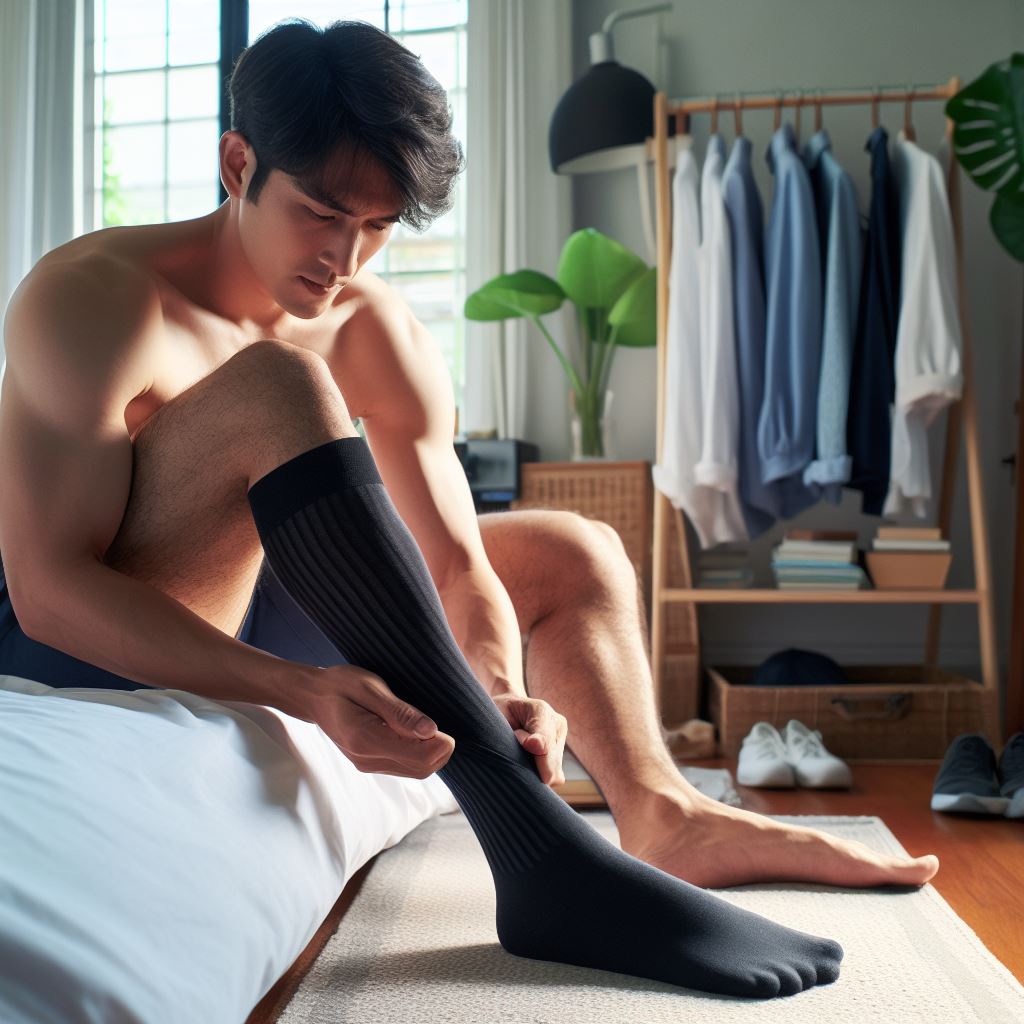
Remember, if you’re having difficulty putting on your compression sock, it’s important to seek assistance. You may ask a family member, friend, or caregiver for help, or consult with a healthcare professional for guidance.
Additionally, if you experience any discomfort, pain, or numbness while wearing a compression sock, it’s important to remove it and seek advice from a healthcare provider. They can help ensure you have the right size and level of compression for your specific needs.
Taking the compression sock off
- Begin by grasping the top of the sock and gently turn it inside out, moving it towards the ankle.
- Insert your thumbs between the sock and your leg, and smoothly slide the sock down towards your toes.
- Finally, delicately tug on the sock to completely take it off from your foot.

Types of Compression Sock
| Brand | Common Uses |
|---|---|
| Sockwell | Everyday wear, travel, reducing swelling in legs and feet |
| Jobst | Managing symptoms of venous diseases (DVT, lymphedema, varicose veins) |
| Vim & Vigr | Improving circulation, reducing swelling, preventing fatigue during long periods of standing or sitting |
| Medi | Managing chronic venous insufficiency, edema, venous ulcers |
| Therafirm | Suitable for athletes and active individuals, moisture-wicking, promoting better blood flow, reducing leg fatigue |
| Sigvaris | Medical and athletic purposes, various compression levels and styles (knee-high, thigh-high, pantyhose) to address circulation issues and lifestyle needs |
| Cep | Improving athletic performance, reducing muscle soreness during and after workouts, recovery, preventing injuries like shin splints and calf cramps |
| Zensah | Seamless technology for comfort, used by runners, cyclists, and athletes to enhance performance, reduce muscle vibration, speed up recovery |
1. Graduated Compression Socks: These are the most common type of compression socks. They are tighter around the ankle and gradually decrease in pressure as they move up the leg. This design helps to push blood back towards the heart, which can be particularly beneficial for individuals with circulation issues.
2. Anti-Embolism Sock: These are specially designed for patients who are bedridden or have limited mobility. They provide a uniform level of compression to prevent blood clots (deep vein thrombosis) from forming.
3. Thigh-High vs. Knee-High vs. Below-Knee: Compression socks come in various lengths to accommodate different needs. Knee-high socks cover the area from the toes to just below the knee, while thigh-high socks extend up to the thigh. Below-knee socks cover the area from the toes to the middle of the calf.
4. Open-Toe vs. Closed-Toe: Some compression socks have an open-toe design, allowing for more freedom for the toes, while others have a closed-toe design.
5. Medical vs. Athletic Compression Socks: Medical-grade compression socks are typically prescribed by a healthcare professional and provide specific levels of compression for medical conditions. Athletic compression socks are designed to enhance performance during sports and exercise, often with less compression than medical-grade socks.
Sockwell
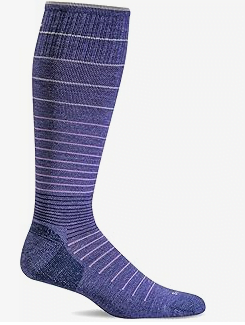
Compression Socks Levels of pressure
Compression socks come in different levels of pressure, typically measured in millimeters of mercury (mmHg). The choice of compression level depends on the specific needs of the individual:
- Mild (8-15 mmHg): Often used for prevention and relief of minor swelling, fatigue, or discomfort in the legs and feet. They are also commonly used for long flights or periods of prolonged sitting.
- Moderate (15-20 mmHg): Recommended for individuals with mild to moderate varicose veins, edema (swelling), or those at risk for deep vein thrombosis.
- Firm (20-30 mmHg): Often prescribed for more severe cases of venous insufficiency, varicose veins, or after certain medical procedures.
- Extra Firm (30-40 mmHg): Used for severe cases of venous insufficiency, lymphedema, and more complex medical conditions.
- Prescription Strength (40+ mmHg): Reserved for serious medical conditions and are only available with a doctor’s prescription.
It’s important to note that choosing the right type of compression sock and the appropriate level of compression should be done under the guidance of a healthcare professional, particularly for those with specific medical conditions. They can provide advice on the type, level, and fit of compression socks that will be most effective for an individual’s needs.
Benefits athletes derive from wearing compression socks or stockings
1. Improved Circulation: Compression garments are designed to apply pressure to the limbs, which can help improve blood circulation. Better circulation means more efficient delivery of oxygen and nutrients to muscles during exercise, potentially enhancing performance and reducing fatigue.
2. Reduced Muscle Fatigue: Compression garments may help reduce muscle vibration during physical activity, which can lead to less muscle fatigue and soreness. This can be particularly beneficial during activities that involve repetitive movements, such as running or cycling.
3. Fast Recovery: Wearing compression garments post-exercise is believed to aid in the removal of metabolic waste products from the muscles, such as lactic acid, which can speed up the recovery process and reduce muscle soreness.
4. Minimized Swelling and Edema: Compression garments can help prevent or reduce swelling and edema by promoting the movement of fluid from the limbs back toward the heart, which is especially relevant for athletes who engage in high-impact activities or long-duration events.
5. Joint Stability: Some compression garments provide additional support to joints, which can enhance proprioception and stability during movement, reducing the risk of injury
What is a Compression Stocking
A compression stocking is a specialized hosiery garment designed to improve blood circulation in the legs. It exerts gentle pressure on the legs, with the highest pressure at the ankles and gradually decreasing as it moves up the leg. This helps to promote better blood flow from the lower extremities back to the heart.
Compression stockings come in different lengths, including knee-high, thigh-high, and full-length stockings or pantyhose. They are available in various compression levels, which are measured in millimeters of mercury (mmHg). The appropriate level of compression will depend on the specific medical condition and the recommendation of a healthcare professional.
It’s important to note that compression stockings should be prescribed and fitted by a healthcare provider. Wearing improperly fitting compression stockings can potentially cause harm.
Benefits of compression Stocking
Compression stockings are commonly used to treat various circulatory conditions, including:
- Venous Insufficiency: This is a condition where the veins in the legs have difficulty returning blood to the heart, often leading to symptoms like swelling, pain, and varicose veins.
- Deep Vein Thrombosis (DVT): Compression stockings are often prescribed for individuals at risk of developing blood clots, as they can help prevent the formation of clots in the deep veins of the legs.
- Lymphedema: This is a condition characterized by swelling due to the accumulation of lymphatic fluid. Compression stockings can help reduce this swelling.
- Varicose Veins: These are swollen, twisted veins that you can see just under the surface of the skin. Compression stockings can help alleviate symptoms associated with varicose veins.
- Preventing Blood Clots during Travel: Some people wear compression stockings on long flights or car journeys to help prevent blood clots from forming.
- Post-Surgery or Injury: After certain surgical procedures, particularly those involving the legs or after an injury, compression stockings might be recommended to help with healing and prevent complications.
Types of compression Stockings
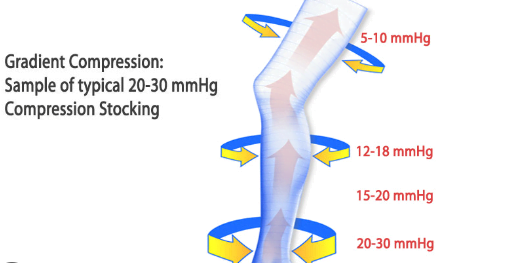
- Graduated Compression Stockings:
- These are the most common type of compression stockings.
- They provide the highest level of compression at the ankle and gradually decrease in pressure as they go up the leg.
- Anti-Embolism Stockings:
- Also known as TED (Thrombo-Embolic Deterrent) stockings.
- These are designed for patients who are non-ambulatory (bedridden) to help prevent blood clots.
- Medical Compression Stockings:
- These are prescribed by a doctor for specific medical conditions like venous insufficiency, lymphedema, and deep vein thrombosis (DVT).
- Non-Medical Compression Stockings:
- These are available without a prescription and are designed for general comfort and leg health.
- They may provide lower levels of compression and are often used for travel, exercise, or to reduce leg fatigue.
- Maternity Compression Stockings:
- These are designed for pregnant women to help alleviate swelling and discomfort in the legs.
- Travel Compression Stockings:
- These are designed to prevent deep vein thrombosis (DVT) during long flights or car trips.
- They provide mild to moderate compression.
- Sport Compression Stockings:
- These are designed for athletes to improve performance, reduce muscle fatigue, and aid in recovery.
- They provide targeted compression in specific zones.
- Fashion Compression Stockings:
- These are designed to look like regular hosiery or socks while providing compression benefits.
- They are available in various styles and colors.
- Arm Compression Sleeves:
- These are similar to compression stockings but are designed for the arms.
- They are used to manage conditions like lymphedema.
- Fingerless Compression Gloves:
- These provide compression for the hands and fingers and are often used to manage conditions like arthritis.
- Custom-Made Compression Garments:
- These are specially designed and tailored to fit an individual’s unique measurements.
- They are often used for complex medical conditions.
- Silicone Top Band vs. Regular Top Band:
- Some compression stockings have a silicone top band to help keep them in place, especially for individuals with mobility issues.
It’s important to note that the type of compression stocking you need should be determined by a healthcare professional based on your specific condition and needs. Improperly fitted or incorrect compression stockings can do more harm than good. Always consult a healthcare provider for proper guidance.
Step by Step when Applying Compression Stockings
Applying compression stockings correctly is important for them to be effective. Here’s a step-by-step guide on how to put on compression stockings:
Materials Needed:
- Compression stockings
- Clean hands
Steps:
- Prepare Yourself:
- Make sure your hands are clean and dry to avoid introducing any dirt or bacteria into the stockings.
- Choose the Right Time:
- It’s usually easier to put on compression stockings in the morning when your legs are less swollen.
- Sit Down:
- Find a comfortable place to sit. If you have difficulty balancing, sit on a bed or a sturdy chair.
- Insert Your Hand:
- Place your hand inside the stocking until you reach the heel.
- Gather the Stocking:
- Gather the stocking by holding onto the heel and turning it inside out.
- Insert Your Foot:
- While still holding the heel, carefully place your foot into the stocking. Make sure your toes are positioned correctly.
- Unroll the Stocking:
- Slowly unroll the stocking up your leg. Be gentle and avoid pulling or tugging, as this can damage the fabric.
- Smooth Out Wrinkles:
- Once the stocking is in place, use your hands to smooth out any wrinkles or folds. Ensure the fabric lies flat against your skin.
- Check for Proper Fit:
- Make sure the top of the stocking sits just below the bend of your knee. It should be snug but not too tight. If you feel discomfort, readjust.
- Repeat for the Other Leg:
- Repeat steps 4 through 9 for the other leg.
- Final Adjustments:
- Stand up and move around a bit. This will help you make sure the stockings feel comfortable and are in the correct position.
Tips:
- If you find it difficult to put on compression stockings, you can use a specialized stocking donning aid, which is a device designed to assist in the process.
- Avoid rolling the stocking down. If it starts to roll, take it off and start again.
- If you have any concerns or difficulties, consult a healthcare professional for guidance.
Remember that it’s essential to wear compression stockings as prescribed by your healthcare provider. They can provide benefits for conditions like deep vein thrombosis (DVT), varicose veins, and other circulatory issues. If you experience any discomfort or pain while wearing them, consult your healthcare provider for advice.
Differences between compression socks and compression stockings:
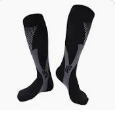
1. Compression Socks: Typically reach just below the knee.
2. Compression Socks: Focus on the lower leg, ankle, and foot.
3. Compression Socks: Commonly used for mild to moderate venous insufficiency, edema, and varicose veins.
4. Compression Socks: Address a wide range of circulatory problems, including mild swelling and varicose veins.
5. Compression Socks: Available in various styles, including athletic, casual, and formal designs. They come in a wide range of colors and patterns.
6. Compression Socks: Easier to put on and take off due to their shorter length.
7. Compression Socks: Suitable for everyday wear and are often chosen by individuals who need compression during specific activities or for preventive measures.
8. Compression Socks: Generally more affordable than compression stockings.
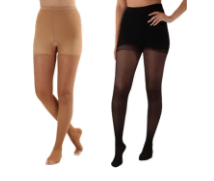
1. Compression Stockings: Extend further up the leg, often covering the entire thigh.
2. Compression Stockings: Cover the entire leg, from foot to thigh
3. Compression Stockings: Suitable for more severe venous issues, post-operative recovery, and advanced stages of conditions like lymphedema.
4. Compression Stockings: Typically recommended for more serious venous disorders and post-surgical recovery.
5. Compression Stockings: Tend to have a medical or clinical appearance. They may come in neutral or skin-tone colors.
6.Compression Stockings: Can be a bit more challenging to don, especially thigh-high or pantyhose styles.
7. Compression Stockings: Frequently recommended for individuals with chronic or severe venous conditions who require continuous support.
8. Compression Stockings: Can be more expensive, especially higher-end, medical-grade options.
Both compression socks and compression stockings come in different levels of compression, which should be prescribed by a healthcare professional based on the specific needs of the individual.
- Both may be constructed from similar elastic materials, but the specific design and weave may vary based on the intended purpose and level of compression.
Remember, regardless of whether one chooses compression socks or stockings, it’s crucial to consult a healthcare professional for proper fitting and to determine the appropriate level of compression for individual needs.
When to apply Compression Stocking and Compression Sock
Compression socks and stockings are typically worn to improve blood flow in the legs and can be beneficial in various situations. Here are some common scenarios when wearing them may be recommended:
1. Long Flights or Travel: Prolonged periods of sitting during air travel can lead to reduced blood circulation. Wearing compression socks can help prevent blood from pooling in the legs and reduce the risk of developing blood clots.
2. Standing or Sitting for Extended Periods: If your job or daily routine involves long hours of standing or sitting, especially without much movement, compression socks can help improve blood flow and reduce swelling.
3. During Pregnancy: Pregnant women often experience swelling and discomfort in their legs due to increased pressure on blood vessels. Compression stockings can provide relief from these symptoms.
4. Post-Surgery or Injury: After surgery or injury, wearing compression socks can aid in reducing swelling and promoting faster healing by enhancing blood circulation.
5. Athletic Activities: Athletes, especially those involved in activities like running, cycling, or other high-impact sports, can benefit from wearing compression socks to enhance performance and speed up recovery by improving blood flow and reducing muscle fatigue.
6. Varicose Veins or Spider Veins: Compression stockings can help alleviate symptoms associated with varicose veins or spider veins by providing support to the blood vessels and improving circulation.
7. Chronic Venous Insufficiency: People with conditions like chronic venous insufficiency, where the veins struggle to return blood to the heart, may benefit from wearing compression garments to manage symptoms.
8. Lymphedema: Individuals with lymphedema, a condition where excess fluid accumulates in tissues, can benefit from compression garments to help manage swelling.
9. Preventing Deep Vein Thrombosis (DVT): Compression stockings may be prescribed to individuals at high risk for DVT, such as those with a history of blood clots or those who have recently undergone surgery.
10. Recovery after Endovenous Laser Treatment (EVLT) or Sclerotherapy: After procedures to treat varicose veins or spider veins, compression stockings are often recommended to support the healing process.
It’s important to consult a healthcare professional before using compression socks or stockings, especially if you have any underlying medical conditions. They can provide guidance on the appropriate type, level of compression, and duration of use for your specific situation.
Is it better better to wear a compression Socks or Stockings?
The choice between wearing compression socks or stockings depends on your specific needs and the area of your legs that requires compression. Here’s a comparison to help you decide which might be better for you.
| Compression Socks | Compression Stockings |
|---|---|
| Coverage: Foot to knee | Coverage: Foot to thigh or waist |
| Best For: Lower leg issues (calf pain, ankle swelling) | Best For: Whole leg issues (severe varicose veins, edema) |
| Ease of Use: Easier to put on and take off | Ease of Use: More challenging to wear, covers more area |
| Athletes, travelers, those with mild swelling | Individuals with severe vascular conditions or post-surgery |
| Weather Suitability: More comfortable in warm weather | Weather Suitability: May be less comfortable in warm weather |
Compression Socks:
- Coverage: Compression socks typically cover from the foot up to the knee. They are ideal if your symptoms or medical conditions affect your lower legs, such as in the case of calf pain, ankle swelling, or varicose veins in the lower legs.
- Convenience: Easier to put on and take off compared to full-length stockings. They are also more comfortable in warmer weather.
- Usage: Commonly used by athletes, travelers, and people who stand or sit for long periods. They are also recommended for individuals with mild to moderate lower leg swelling or for the prevention of deep vein thrombosis (DVT) during travel.
Compression Stockings:
- Coverage: Compression stockings extend from the foot up to the thigh or waist. They are suitable if you have conditions that affect your entire leg, such as severe varicose veins, edema, or deep vein thrombosis in the upper leg.
- Support: They provide more comprehensive support, which is beneficial if you have issues above the knee.
- Usage: Typically recommended for individuals with more severe vascular conditions or for those who need full-leg support post-surgery or during pregnancy.
Which is Better?
- For Lower Leg Issues: If your primary concerns are in your lower legs, compression socks may be sufficient and more comfortable.
- For Whole Leg Issues: If you need support for the entire leg or have more severe vascular issues, compression stockings might be the better option.
If you have a medical condition requiring compression wear, it’s advisable to consult with a healthcare professional for personalized advice on the best option for you.
Which is better for Skin Sensitivity Compression Sock vs Stocking
Compression socks and stockings can have different impacts on individuals with sensitive skin or conditions like eczema or psoriasis due to their material, fit, and design.
Compression Socks:
- Material: Compression socks are often made from synthetic materials like nylon and spandex, which can sometimes irritate sensitive skin. However, there are options made from softer, hypoallergenic materials like cotton blends or bamboo, which are gentler on the skin.
- Fit and Elasticity: The snug fit of compression socks can trap moisture against the skin, potentially aggravating conditions like eczema or psoriasis. However, some socks are designed with moisture-wicking properties to help keep the skin dry and reduce irritation.
- Seam Placement: The placement and type of seams in compression socks can cause friction, leading to discomfort or worsening of skin conditions. Seamless or flat-seamed options are generally better for sensitive skin.
Compression Stockings:
- Material: Like compression socks, stockings are often made from synthetic materials, but they can sometimes be thicker and less breathable. This can increase the risk of irritation for those with skin conditions.
- Coverage: Compression stockings typically cover a larger area of the leg, which can exacerbate skin sensitivity issues, especially if the skin is prone to dryness or flakiness. This extended coverage can also increase the chances of friction and irritation.
- Fit and Comfort: The tight fit of compression stockings can lead to discomfort, particularly if they are not properly sized. Improper fit can cause pressure marks or exacerbate existing skin conditions. Stockings with a softer, more flexible top band can be more comfortable for sensitive skin.
Considerations for Sensitive Skin:
- Material Choice: Opt for hypoallergenic, breathable materials that reduce the risk of irritation.
- Moisturization: Applying a gentle, fragrance-free moisturizer before wearing compression garments can help protect the skin.
- Proper Fit: Ensuring the correct size and fit is crucial to prevent unnecessary friction and pressure.
- Seamless Options: Choosing seamless or flat-seamed garments can minimize irritation from rubbing.
For individuals with sensitive skin or conditions like eczema or psoriasis, it’s essential to select compression garments carefully, paying close attention to material, fit, and the presence of moisture-wicking properties. Consulting with a healthcare professional or dermatologist before choosing a compression product is also advisable.
How do compression Socks and Stockings perform in extreme cold or hot climates?
Compression socks and stockings can behave differently depending on the climate, and understanding these differences is crucial for maximizing comfort and efficacy.
Performance in Extreme Cold Climates
- Insulation: Compression socks and stockings provide some level of insulation due to the snug fit and thicker materials. This can help retain body heat, making them beneficial in cold climates. However, the level of warmth depends on the material composition. Wool or merino wool compression socks, for instance, are particularly effective in cold weather as they provide better insulation while still allowing for breathability.
- Moisture Management: In cold climates, moisture-wicking properties are essential. Socks made from synthetic fibers like nylon, polyester, or a blend with merino wool can effectively manage sweat, keeping feet dry and reducing the risk of frostbite. Wet feet can become colder much faster, so moisture management is key.
- Layering: In extremely cold conditions, compression socks can be worn as a base layer under thicker thermal socks. This layering approach can enhance warmth without compromising the benefits of compression.
- Circulation: The primary function of compression socks—to improve circulation—can be especially beneficial in cold climates, where circulation might be reduced. Enhanced blood flow can help keep extremities warmer.
Performance in Extreme Hot Climates
- Breathability: In hot climates, breathability is crucial. Compression socks and stockings made from lightweight, moisture-wicking materials like Coolmax, or with mesh panels, can enhance airflow and prevent overheating. Cotton, while comfortable, tends to retain moisture and may not be the best choice for hot environments.
- Moisture Control: In hot weather, feet are prone to sweating. Compression socks with good moisture-wicking capabilities help keep the skin dry, reducing the risk of blisters, fungal infections, or discomfort. Some modern compression socks are designed with antimicrobial properties to further reduce odor and the risk of infection.
- Thickness and Material: Thinner compression socks are generally more comfortable in hot climates. Lightweight synthetic fabrics that promote moisture evaporation can help maintain a cooler foot temperature.
- Comfort: Wearing compression garments in extreme heat can sometimes feel constricting or uncomfortable. It’s essential to choose socks with a lower compression level if comfort becomes an issue in hot weather, as higher compression levels might feel too tight and exacerbate heat discomfort.
Overall Considerations
- Adaptation: The adaptability of compression socks and stockings to different climates largely depends on the material used. For example, merino wool blends are versatile, offering warmth in the cold and breathability in the heat.
- Activity Level: Your activity level also plays a role. If you’re very active in either extreme cold or hot climates, choosing compression socks designed for athletic use can offer additional features like extra cushioning, enhanced moisture management, and better temperature control.
In both extreme cold and hot climates, selecting the right material and compression level is key to ensuring that compression socks and stockings perform optimally while maintaining comfort.
Resources
https://bayshoremedicalsupply.net/compression-socks-and-stockings
https://www.webmd.com/dvt/choose-compression-stockings
https://procompression.com/blogs/articles/compression-socks-or-calf-sleeves








